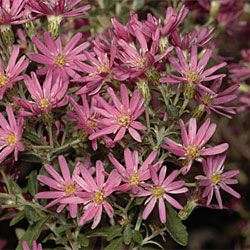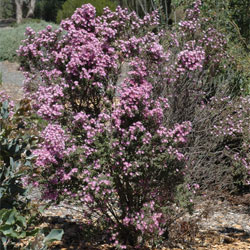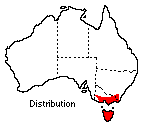Olearia phlogopappa
 |
 |
Alpine Daisy Bush
Olearia phlogopappa (Labill.) DC.
An Alpine Daisy Bush in full flower is often taken for one of the Michaelmas Daisies, which, however, are species of Aster, true perennials of the Northern Hemisphere, especially North America.
The genus Olearia (Daisy Bushes) is closely related to Aster,
but comprises shrubs or small trees native to Australasia, about eighty of them
being endemic to Australia and found in all situations. Half-hardy species are
well known in European gardens, as in Ireland and southern England, and in this
country about ten are offered in cultivation. One of the most popular is the
species described here, Olearia phlogopappa, a lightweight shrub from
Tasmania, Victoria and New South Wales, easily grown, very hardy and bringing
quick results. 
The shrub has a generally grey appearance from the coating of hairs on young growth and the undersides of the leaves, which are under 2.5 cm long, narrow and with dentate edges. There is a strong musky odour, found also in other Olearia spp. and often in other members of the family Asteraceae. The flowers have a different scent, light and pleasant.
Flowering starts around the end of September and gradually the thin stems lean with the weight of massed daisies in rounded heads. Light violet and purple-pinks are the popular colours although the white form is more common in nature. If conditions are cool and moist the season extends into December, but if hot and dry the season is short.
Dry conditions do not bring out the best in this shrub and if a position in light shade can be found, along with regular watering, growth will be more lush. It is, at times, a dry-looking plant with lower leaves dying out, leading to bare wood and a poor shape. Light pruning helps to increase bushiness if started while the plant is young, as older wood does not break freely into growth. Pruning should be carried out after flowering, although short sprays taken as cut flowers have the same effect as pruning.
Left alone the form is upright and narrow, about 2 m high. A useful idea is to grow the shrub among or behind small shrubs to hide the sometimes untidy base. If required for a seaside garden it should not be exposed to sea winds. As with most native species light dressings of blood and bone or a general fertiliser are beneficial in early spring and late summer.
Plants receiving adequate water are long lived and as they are easily raised from cuttings, young plants may be kept on hand in case of loss if desired. Also, they are frequently stocked by nurseries dealing in native species. The only disease noticed here has been die-back of branches possibly as a result of root-rot fungus when continuous rains and cold weather prevented natural drying out of the soil. This can be dealt with only by assisting drainage in any way possible and relying on the vigour of the plant for recovery.
Based on text by ANBG staff (1972)
Name meaning: Olearia phlogopappaOlearia - named in honour of German botanist, J.G.Oelschlaeger (1635-1711) [Latinised as Olearius]; phlogopappa - from two Greek words, phlogos, flame, and pappos, pappus, a group of appendages (often hairs or scales) attached above the ovary in members of the daisy family. The original description of this species alludes to the pappus being flame-coloured. |
![An Australian Government Initiative [logo]](/images/austgovt_brown_90px.gif)

